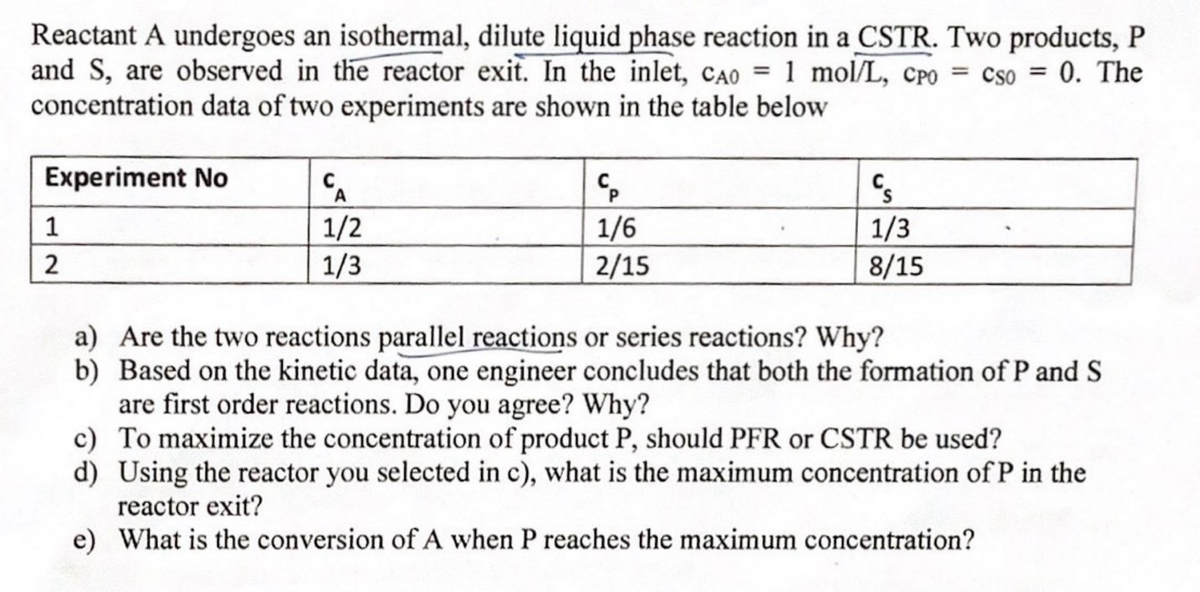Reactant A undergoes an isothermal, dilute liquid phase reaction in a CSTR. Two products, P and S, are observed in the reactor exit. In the inlet, CAO = 1 mol/L, CPO = cso = 0. The concentration data of two experiments are shown in the table below Experiment No CA 1 2 1/2 1/3 CP 1/6 2/15 1/3 8/15 a) Are the two reactions parallel reactions or series reactions? Why? b) Based on the kinetic data, one engineer concludes that both the formation of P and S are first order reactions. Do you agree? Why? c) To maximize the concentration of product P, should PFR or CSTR be used? d) Using the reactor you selected in c), what is the maximum concentration of P in the reactor exit? e) What is the conversion of A when P reaches the maximum concentration?
Reactant A undergoes an isothermal, dilute liquid phase reaction in a CSTR. Two products, P and S, are observed in the reactor exit. In the inlet, CAO = 1 mol/L, CPO = cso = 0. The concentration data of two experiments are shown in the table below Experiment No CA 1 2 1/2 1/3 CP 1/6 2/15 1/3 8/15 a) Are the two reactions parallel reactions or series reactions? Why? b) Based on the kinetic data, one engineer concludes that both the formation of P and S are first order reactions. Do you agree? Why? c) To maximize the concentration of product P, should PFR or CSTR be used? d) Using the reactor you selected in c), what is the maximum concentration of P in the reactor exit? e) What is the conversion of A when P reaches the maximum concentration?
Introduction to Chemical Engineering Thermodynamics
8th Edition
ISBN:9781259696527
Author:J.M. Smith Termodinamica en ingenieria quimica, Hendrick C Van Ness, Michael Abbott, Mark Swihart
Publisher:J.M. Smith Termodinamica en ingenieria quimica, Hendrick C Van Ness, Michael Abbott, Mark Swihart
Chapter1: Introduction
Section: Chapter Questions
Problem 1.1P
Related questions
Question

Transcribed Image Text:Reactant A undergoes an isothermal, dilute liquid phase reaction in a CSTR. Two products, P
and S, are observed in the reactor exit. In the inlet, CAO = 1 mol/L, CPO = cso = 0. The
concentration data of two experiments are shown in the table below
Experiment No
CA
1
2
1/2
1/3
CP
1/6
2/15
1/3
8/15
a) Are the two reactions parallel reactions or series reactions? Why?
b) Based on the kinetic data, one engineer concludes that both the formation of P and S
are first order reactions. Do you agree? Why?
c) To maximize the concentration of product P, should PFR or CSTR be used?
d) Using the reactor you selected in c), what is the maximum concentration of P in the
reactor exit?
e) What is the conversion of A when P reaches the maximum concentration?
Expert Solution
This question has been solved!
Explore an expertly crafted, step-by-step solution for a thorough understanding of key concepts.
Step by step
Solved in 2 steps with 2 images

Recommended textbooks for you

Introduction to Chemical Engineering Thermodynami…
Chemical Engineering
ISBN:
9781259696527
Author:
J.M. Smith Termodinamica en ingenieria quimica, Hendrick C Van Ness, Michael Abbott, Mark Swihart
Publisher:
McGraw-Hill Education

Elementary Principles of Chemical Processes, Bind…
Chemical Engineering
ISBN:
9781118431221
Author:
Richard M. Felder, Ronald W. Rousseau, Lisa G. Bullard
Publisher:
WILEY

Elements of Chemical Reaction Engineering (5th Ed…
Chemical Engineering
ISBN:
9780133887518
Author:
H. Scott Fogler
Publisher:
Prentice Hall

Introduction to Chemical Engineering Thermodynami…
Chemical Engineering
ISBN:
9781259696527
Author:
J.M. Smith Termodinamica en ingenieria quimica, Hendrick C Van Ness, Michael Abbott, Mark Swihart
Publisher:
McGraw-Hill Education

Elementary Principles of Chemical Processes, Bind…
Chemical Engineering
ISBN:
9781118431221
Author:
Richard M. Felder, Ronald W. Rousseau, Lisa G. Bullard
Publisher:
WILEY

Elements of Chemical Reaction Engineering (5th Ed…
Chemical Engineering
ISBN:
9780133887518
Author:
H. Scott Fogler
Publisher:
Prentice Hall


Industrial Plastics: Theory and Applications
Chemical Engineering
ISBN:
9781285061238
Author:
Lokensgard, Erik
Publisher:
Delmar Cengage Learning

Unit Operations of Chemical Engineering
Chemical Engineering
ISBN:
9780072848236
Author:
Warren McCabe, Julian C. Smith, Peter Harriott
Publisher:
McGraw-Hill Companies, The